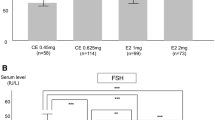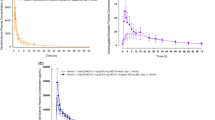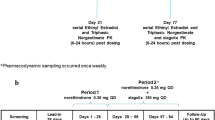Summary
Objective
the aim of the study was to assess the bioavailability of estradiol (E2) following oral, single-dose administration of equimolar doses of three HRT preparations in a 3-way cross-over study in postmenopausal women.
Methods
18 healthy subjects were enrolled. Free E2 and estrone (E1) serum concentrations were determined using commercially available immunoassay kits. Bioequivalence testing was performed between the following oral formulations: (a) 1.5 mg E2 tablets versus 2 mg E2 V tablets; and (b) 1.5 mg E2 plus 0.15 mg DSG tablets versus 1.5 mg E2 tablets.
Results
for both E2 and E1, the E2 tablet was bioequivalent with both the E2 V and the E2/DSG tablet with respect to the rate and extent of absorption (bioavailability). Although the meant tmax values of the three tablet formulations were similar, the variability was too large to prove formal bioequivalence.
Conclusion
E2 tablets and E2/DSG tablets were bioequivalent and also bioequivalence of E2 tablets with commercially available E2 V was found, which ensures a sequential HRT preparation without large variations in estrogen serum concentrations.
Similar content being viewed by others
References
Borglin N.E., Staland B. (1975): Oral treatment of menopausal symptoms with natural estrogens. Acta Obstet. Gynecol. Scand., 43: 1–11.
Clisham P.R., Ziegler D. de, Lozano K., Judd H.J. (1991): Comparison of continuous versus sequential estrogen and progestin therapy in postmenopausal women. Obstet. Gynecol., 77: 241–246.
Christiansen C., Christiansen M.S., Larsen N.E., Transbol I. (1982): Pathophysiological mechanisms of estrogen effect on bone metabolism. Dose-response relationships in early postmenopausal women. J. Clin. Endocrinol. Metab., 55: 1124–1130.
Mazess R.B., Gallagher J.C., Notelovitz M., Schiff I., Utian W. (1989): Monitoring skeletal response to estrogen. Am. J. Obstet. Gynecol., 161: 843–848.
Lufkin E.G., Carpenter P.C., Ory S.J., Malkasian G.D., Edmonson J.H. (1988): Estrogen replacement therapy; current recommendations. Mayo Clin. Proc., 63: 453–460.
Whitehead M.I., King R.J.B., McQueen I., Campbell S. (1979): Endometrial histology and biochemistry in climacteric women during oestrogen and oestrogen/progestagen therapy. J. R. Soc. Med., 72: 322–327.
Whitehead M.I., Townsend P.T., Pryse-Davies J., Ryder T.A., King R.J.B. (1981): Effects of estrogen and progestins on the biochemistry and morphology of the postmenopausal endometrium. N. Engl. J. Med., 305: 1599–1605.
Persson I., Adami H-O., Bergkvist L.et al. (1989): Risk of endometrial cancer after treatment with oestrogens alone or in conjunction with progestogens: results of a prospective study. BMJ, 298: 147–151.
Gambrell R.D. (1986): Prevention of endometrial cancer with progestogens. Maturitas, 8: 169–176.
Saure A., Hirvonen E., Tikkanen M.J., Viinikka L., Ylikorkala O. (1993): A novel oestradiol-desogestrel preparation for hormone replacement therapy; effects on hormones, lipids, bone, climacteric symptoms and endometrium. Maturitas, 16: 1–12.
Marslew U., Riis B.J., Christiansen C. (1991): Desogestrel in hormone replacement therapy: long-term effects on bone, calcium and lipid metabolism, climacteric symptoms, and bleeding. Eur. J. Clin. Invest., 21: 601–607.
Chen M.L. (1992): Guidance statistical procedures for bioequivalence studies using a standard two-treatment cross-over design, Division of Bioequivalence, Office of Generic Drugs (OGD) of the FDA, informal communication 21 CFR 10.90 (b) (9), July.
International harmonization and consensus DIA meeting on bioavailability and bioequivalence testing requirements and standards. (1991): Drug Inform. J., 25: 471–482.
Steinijans V.W., Diletti E. (1983): Statistical analysis of bioavailability studies. Eur. J. Clin. Pharmacol., 23: 127–136.
Winer B.J. (1971): Statistical principles in experimental design. 2nd edn. New York: McGraw-Hill, 693–696.
Reynolds J.E.F. (1982): Martindale, 28th edn; London: Pharmaceutical Press, 1425–1427.
Midha K.K. (1990): Bio-International 1989. Int. J. Pharm. 4: 101–103.
Author information
Authors and Affiliations
Rights and permissions
About this article
Cite this article
Timmer, C.J., Geurts, T.B.P. Bioequivalence assessment of three different estradiol formulations in postmenopausal women in an open, randomized, single-dose, 3-way cross-over study. Eur. J. Drug Metab. Pharmacokinet. 24, 47–53 (1999). https://doi.org/10.1007/BF03190010
Received:
Issue Date:
DOI: https://doi.org/10.1007/BF03190010




